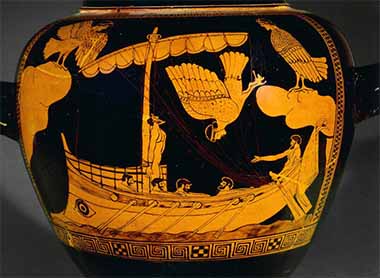History of Greek Sirens Power And Middle Ages Folkore Myths
The Deadly Song of the Fish Woman

Sirens are mythological characters whose haunting sounds lure sailors to their death. Their methods of seduction vary from one story to another. All exert an unparalleled appeal on sailors.
Odysseus and the sirens
The earliest evidence of the appearance of the sirens can be traced back to Homer's Odyssey, which recounts the tumultuous adventures of the Greek hero Odysseus during his long journey back to Ithaca after the Trojan War.
In Greek mythology, sirens live on an island in the Mediterranean. Their songs are so beautiful that the sailors who hear them can not resist and throw their ships on the rocks. Survivors are ruthlessly killed. Their name comes from the Latin word siren, itself derived from the Greek seirên, the word seira, the link, the rope, recalling no doubt their captivating power.
When Odysseus leaves the home of the magician Circe, he knows he must pass near the island of the sirens. On the advice of the enchantress, the wily hero then resorted to a ploy allowing him to hear the songs while saving his ship and his companions. Odysseus stuffs his men's ears with wax after asking to be securely attached to the mast. He can thus satisfy his curiosity by listening to the song, without giving in to it.
This song is poignant and rich with beautiful promises: don’t sirens claim that "all things that will exist one day on earth, already we know them"? Odysseus yells at his companions to detach him, but they, of course, remain deaf to his cries. The boat passes, and the heroes escape the fatal destiny of so many other sailors.
Greek sirens

The physical appearance of sirens has evolved. In Greek times, they are represented as winged beings, with human face and bird body as evidenced by different ancient Greek vases. Under the Roman Empire, they are confused with the Nereids, the fifty daughters of Nereus, sea god, and Doris, herself a descendant of Oceanus. The beautiful Nereids are the nymphs of the sea and it is not surprising that they were close to the sirens, other marine figures ...
Their transformation into half-female, half-fish creatures, on the back covered with scales, apparently dates back to the Middle Ages and Celtic and Germanic legends.
Medieval european sirens

In the Middle Ages, sirens, which are also attributed to cannibalism, are confused with harpies. Like all half-woman and half-animal monsters, the harpy also belongs to the water element - a dual nature that, in medieval culture, breeds the current type of mermaid, with a bust of a young woman and a tail, and fish fins. Often this woman-fish is confused with the snake-woman, also locally called wyvern.
The symbolism of hybrid women with double nature reflects, in the upper part of the body, the pleasure and the different expressions of femininity, but, below the waist, there is the image of lust and bestiality. Misogynist Christianity has made these beings the emblems of the devil even though, in more recent European folklore (for example in Anderson's tale), sirens have acquired a less negative character.
Manatees and dugongs: harmless sirens
While he is off the West Indies, Christopher Columbus sees three mermaids dancing in the water. They are ugly and dumb, but he discovers in their eyes a "regret of Greece". Today, zoologists believe that manatees are perhaps the origin of the sirens myth and that sailors have long confused them. It is also in reference to the sirens myth that the name of Sirenians has been given to the zoological order to which these aquatic mammals belong. Dugongs and manatees are the only two living representatives of this order.
The last mermaids' ball

Manatees are large animals, up to 2 or 3 meters long, they are also called the less pleasant name of "sea calf". They have a fusiform and hairless body surmounted by a massive head and their harmonious cries certainly contributed to the legend of the sirens song. Especially since the females have two pectoral breasts that can very well pass for the breasts of a woman. They inhabit the coastal rivers of the United States, between North Carolina and the Gulf of Mexico, but they are also found off the west coast of Africa, where the Ancients have been able to see them.
The dugongs can rather be met in the Indian Ocean and in the north of Australia. They are gentle and not very shy and are now threatened with extinction.









































































































































































































































































































































